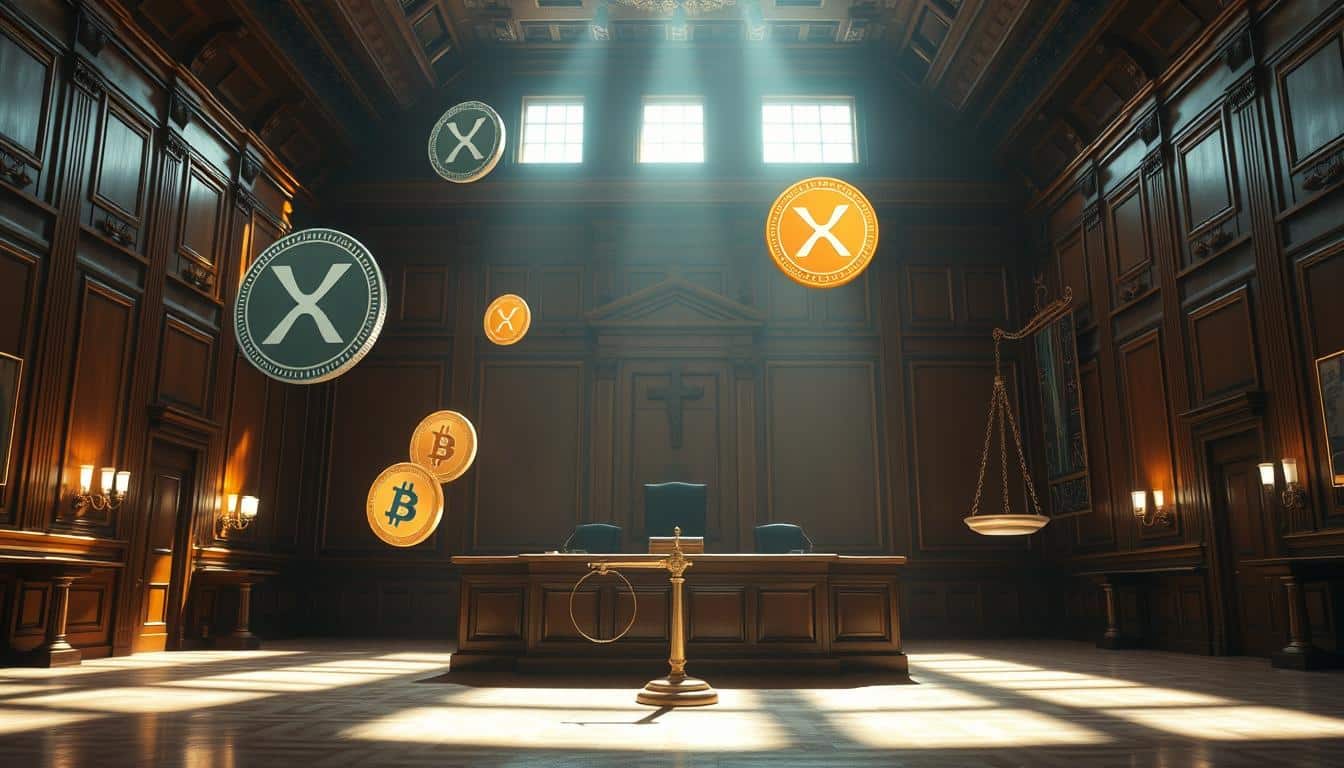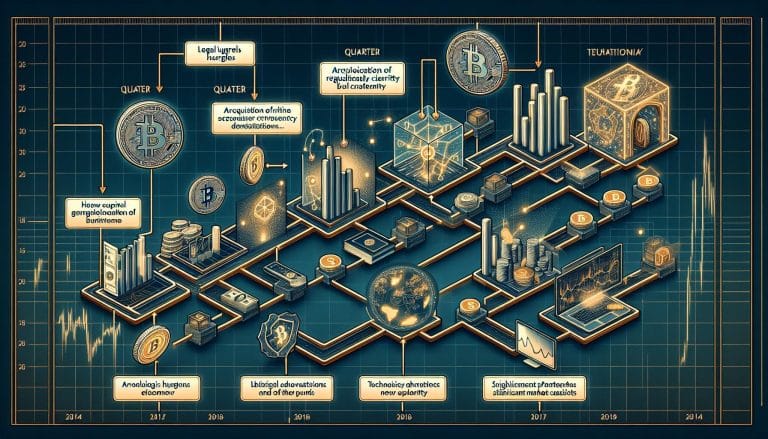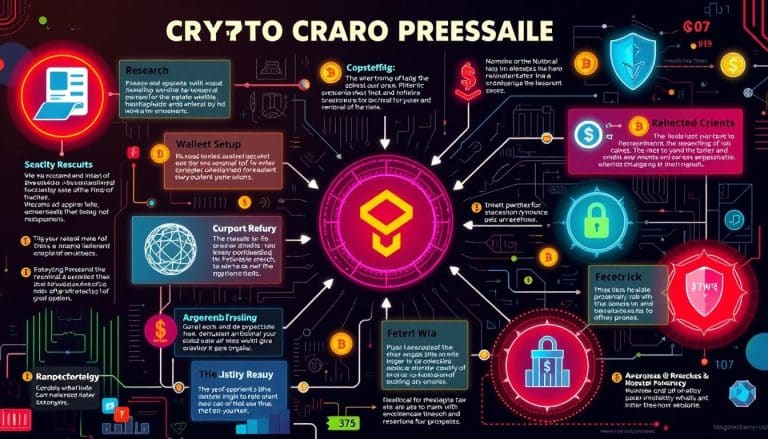Understanding Judge Torres’ XRP Rulings
Ripple’s Programmatic Sales of XRP were less than 1% of global XRP trading. Most buyers didn’t directly invest in Ripple1. This emerged from Judge Analisa Torres’ significant rulings on XRP in July 2025. These decisions greatly influenced the crypto world, changing how investors and markets act.
Specifically, Judge Torres found the SEC’s claim that XRP sales were always securities to be wrong for some transactions. It was a detailed and crucial decision.
Programmatic Sales weren’t considered securities, but Institutional Sales did break securities laws. This has caused a big stir in the cryptocurrency circle. It also preps for an important decision on remedies, expected after March 2025. The SEC wants a $2 billion penalty and an injunction. On the other hand, Ripple offers a $10 million penalty, showing they’ve followed rules since the legal action1.
Moreover, Judge Torres’ decisions have laid a massive impact on how future crypto regulations will look. They also affect Ripple’s day-to-day actions.
Key Takeaways
- Ripple’s Programmatic Sales of XRP were minor, showing few buyers directly invested in Ripple1.
- Judge Torres found Programmatic Sales not to be securities, while Institutional Sales broke the laws1.
- The SEC seeks a $2 billion fine from Ripple, who counters with a $10 million proposal, highlighting adherence to rules post-lawsuit1.
- Judge Torres’ verdicts are reshaping future crypto rules and Ripple’s operations2.
- The case ignited major talk in finance and crypto communities about settlements and what it means for digital asset issuers2.
Introduction to Judge Torres’ XRP Rulings
In the battle between the SEC and Ripple, Judge Torres’ decisions are crucial. They shape future rules and actions for cryptocurrencies. This section looks into the case’s background and why these rulings matter.
Background of the Case
The lawsuit with Judge Torres started in December 2020. The SEC accused Ripple and its leaders of an illegal $1.3 billion digital asset offering, against the Securities Act of 19333. It questioned if Ripple’s cryptocurrency, XRP, was a security by law. The court decided XRP isn’t a security by itself. It said that three out of four kinds of XRP sales weren’t securities3. This judgement separates programmatic and institutional XRP sales, affecting their legal treatment.
Importance of the Rulings
Judge Torres’ decision on XRP is important for a few reasons. It stated that programmatic sales on exchanges didn’t count as securities transactions under the Howey test3. This was a major decision. It showed buyers in such sales were like secondary market buyers, not expecting profits from Ripple’s work3.
Furthermore, despite the Ripple founders initially having 20 billion XRP, they didn’t technically own this amount. This detail makes the case more complex4. Financially, Ripple reported making $609 million from giving XRP to people and companies for services4. The court also denied Ripple’s argument of fair notice, confirming the clear use of securities laws3.
The court rejected the fair notice defense. This underlines the clarity the Howey case laws bring to defining investment contract securities. This acts as a warning on what the crypto industry can or cannot do3.
These detailed decisions in the XRP lawsuit by Judge Torres are being watched by many. Understanding them helps foresee how cryptocurrencies might be regulated and seen under securities laws in the future.
Key Aspects of the SEC vs. Ripple Case
The SEC vs. Ripple lawsuit is big news in the crypto world, mainly about whether XRP is a security. A crucial point is how the Howey Test is used to see if something is an investment contract.
Judge Torres had a major role in the case, making decisions that brought out key points. She imposed a $125 million penalty on Ripple, instead of the $2 billion the SEC wanted5. She decided not to order disgorgement since institutional investors didn’t prove they lost money5. Besides, Ripple was held responsible for $728.9 million in unlicensed securities sales to big investors. Yet, how this affects Ripple’s XRP sales was vital in the final decision6.
Ripple’s CEO, Brad Garlinghouse, was upset with the SEC for not proving fraud or recklessness. This reflects a wider upset in the crypto world with the SEC, which has also targeted companies like Coinbase and Binance6. Ripple’s top lawyer, Stuart Alderoty, is hopeful Judge Torres will be fair in the next phase. This stage is very important for Ripple and the entire crypto market6.
How the verdict affected XRP’s market price is interesting. Although XRP’s price dropped at first, it soon rose, showing a mixed market reaction to the court’s decision5. Judge Torres’ decisions might change how digital assets are regulated. This could greatly impact how other cryptocurrencies are seen and regulated, possibly changing the crypto world.
Programmatic Sales vs. Institutional Sales of XRP
Judge Torres made clear differences between programmatic and institutional sales of XRP in the SEC vs. Ripple case. This was based on the Howey Test. The ruling showed how these sales are regulated differently and affect the cryptocurrency market7.
Determination Using the Howey Test
Judge Torres used the Howey Test to see if transactions were investment contracts. She looked at three elements: an investment of money, in a common enterprise, with an expectation of profits from others’ work8. Institutional sales met all three, so they had to be registered as investment contracts7.
But programmatic sales and other distributions didn’t meet all criteria. So, they weren’t classified as investment contracts7.
Impact on Different Types of Investors
There’s a big difference in how these sales affect investors. Institutional investors faced strict rules because they expected profit from Ripple’s work8. But programmatic buyers, using secondary exchanges, faced fewer regulations due to limited knowledge of Ripple’s role8.
The court’s decision shows a clear line. Institutional sales fall under securities laws. Programmatic sales and certain other distributions do not8.
| Type of Sale | Investment Contract | Regulatory Requirement |
|---|---|---|
| Institutional Sales | Yes | Subject to registration under Securities Act |
| Programmatic Sales | No | Not subject to registration |
| Other Distributions (e.g., compensation for services) | No | Not subject to registration |
Judge Torres’ ruling gives a deeper understanding of the crypto lawsuit space. It sets a guideline for future cases in the digital asset area7. This clarity is crucial for investors. It also hints at what secondary trading platforms might need to consider for compliance7.
Judge Torres’ Judgement on Programmatic Sales of XRP
Judge Torres made a crucial decision that affects the whole cryptocurrency market. She found that XRP’s sales on exchanges aren’t security offerings. This is because these sales weren’t closely tied to Ripple’s marketing efforts. They also made up less than 1% of XRP’s global trading volume9. This point challenges the SEC’s view that these were security sales.
This judgement shows most XRP buyers weren’t investing in Ripple itself. They were just making trades on the market. On July 12, XRP’s value rose by 5.63%, ending the day at $0.4745. This increase reflects the market’s positive reaction to the court’s decision9. Around the same time, the whole crypto market also went up by 1.22%. This brought its market cap to $2.098 trillion9.
Judge Torres also refused the SEC’s ask to give back $876 million from Ripple’s XRP sales10. This action reduces the SEC’s ability to impose high fines in future cases. Ripple was only fined $125 million, much less than the $2 billion the SEC wanted10. During this, XRP’s price saw ups and downs, reaching $0.9327 on July 13, 20259.
Judge Torres’ ruling highlights how different programmatic sales are from direct marketing by firms like Ripple. You can learn more about the decision and what it means by clicking this link. The court took a detailed look at various types of transactions in the crypto world. This sets a guide for future legal cases and may restrain the SEC’s broad interpretations.
Judge Torres’ Findings on Institutional Sales of XRP
Judge Torres recently made key findings in the Ripple case about XRP. She found that sales of XRP to large investors were in fact unregistered securities deals. Her decision was based on the Howey test, showing that investors gave money to Ripple. In return, Ripple worked to boost XRP’s value11. Because of this, Ripple faced a hefty fine of $125.035 million for 1,278 sales to big investors12. This fine was much smaller than the huge amounts the SEC wanted12.
Violation of Securities Laws
Judge Torres made it clear that Ripple’s big sales of XRP broke the law. These deals were different because there was a direct agreement. Here, investors knew their money was used for Ripple’s marketing11. This was unlike Ripple’s other sales on online platforms, which were anonymous11. This detail is crucial for understanding how law treats different kinds of sales, and it challenges the SEC’s view that all crypto deals are the same11.
Response from Crypto Markets
The crypto markets had mixed feelings about Judge Torres’ decision. Many appreciated the clarity, but the mood was cautious. For example, XRP’s price went up slightly by 3 cents after the ruling12. This small change reflects the ongoing talks around the SEC’s possible next steps and what this means for other digital currencies. It’s a reminder of how closely tied the markets are to regulatory news.
| Ripple’s Institutional Sales | Programmatic Sales |
|---|---|
| Violated securities laws | Did not violate federal securities laws |
| 1,278 transactions resulting in $125.035 million fine | Representing less than 1% of global XRP trading volume since 2017 |
| Investors were aware of fund usage | Purchasers unaware if funds went to Ripple |
| Met the Howey test | Did not meet the Howey test |
Legal Implications of Judge Torres’ Rulings
The legal effects of Judge Torres’ decisions on XRP reach far. They look at institutional sales and forecast how cryptocurrency laws might change. The rulings push for a new look at how to regulate digital assets. They show the changing world of crypto law.
Effect on Future Cryptocurrency Regulations
Judge Torres’ decision on Ripple’s $125 million penalty, versus the SEC’s $2 billion demand, is key13. This outcome could shape how future crypto cases are judged. It shows the importance of proving fraud or investor harm for big fines13.
The refusal to make Ripple give up $876 million in profits shows a fairer approach13. This could guide future crypto laws, aiming for more legal clearness. It stresses proving investor losses in legal cases14.
Impact on XRP and Ripple’s Operations
Ripple’s business faces big changes because of Judge Torres’ rulings. Its ODL solution, now seen as a security deal, will get more checks13. Since most ODL sales are outside the U.S., Ripple must adjust to lower legal risks13. Strategies might include avoiding deals in the U.S., seeking exemptions, or registering XRP as a security13.
A permanent court order stops Ripple from future securities law breaks14. This sets a clear line for staying within the law. Ripple needs to adapt to keep doing business without legal issues from the SEC or others.
Judge Torres’ Analysis on Other XRP Distributions
Judge Analisa Torres significantly influenced the cryptocurrency world with her review. She looked into XRP distributions labeled as “Other Distributions,” which cover employee pay and funds for third-party developers.
Employee Compensation
Judge Torres carefully analyzed XRP’s role in employee compensation. She found these distributions didn’t count as investments. By the Howey Test standards, these cases lacked an investment of money. Instead, they were seen as proper compensations for services. So, they weren’t treated as securities transactions15.
Third-party Developer Funding
The investigation into third-party developer funding was just as thorough. Judge Torres pointed out this funding didn’t meet the investment contract criteria. This XRP usage was considered a non-cash consideration, including services. Therefore, these distributions were not securities transactions16. Interestingly, Ripple reported earning $609 million from such “Other Distributions” of XRP17.
Reactions from Crypto Community and Market Analysts
The crypto community and market analysts have given mixed reactions to Judge Torres’ rulings on XRP. Many see it as partly good news for Ripple and possibly a turning point for future crypto cases. The ruling made a key distinction: Ripple’s sales of XRP to big investors were seen as unregistered securities, but sales on secondary exchanges were not18. This has made some people in the market hopeful.
Still, there’s a careful hope as everyone waits to see if there will be settlements or further appeals. Some experts note Judge Torres’ detailed decisions might guide how digital assets are regulated. For example, the Court agreed with the SEC that Ripple’s big sales met the Howey Test, showing a complex legal landscape for crypto regulation18.
On the other side, Ripple’s claim that XRP isn’t a security didn’t win in court18. So, Judge Torres’ rulings are now key references for similar cases in the crypto world. The SEC’s case against Binance and Changpeng Zhao also drew heavily from the 2025 Ripple ruling, especially in dismissing secondary sales claims19. This shows how impactful Judge Torres’ decisions are.
Metalawman, a well-known legal expert, said the rejection of the SEC’s secondary market sales claims was good news for crypto19. This feeling is widespread in the crypto community, suggesting a change in how the law sees digital assets. Everyone’s now looking at what the appeals will bring and how they’ll affect crypto rules.
How Judge Torres’ Rulings Differ from Other Cases
Judge Torres’ work on the Ripple case is quite unique. She closely looked at the details of XRP transactions. Her method was different. She separated institutional sales from other types of sales.
This depth of analysis is not common in the cryptocurrency legal world. It really stands out.
Comparison with Terraform Labs
Judge Torres made interesting findings in the Terraform Labs case. She thought institutional sales of XRP were investment contracts based on the Howey Test. But, she didn’t think the same for programmatic sales and other distributions of XRP2021. On the contrary, Judge Rakoff felt Terraform’s actions met the “common enterprise” part of the Howey Test. Their promotional efforts linked their assets directly to their success20. Terraform marketed UST Coins in the U.S. as a chance for investors to make 19-20% returns20.
Implications for Digital Asset Issuers
Judge Torres’ decision on the XRP lawsuit is very meaningful for those issuing digital assets. Her findings do a great job of highlighting why it’s important to tell different sales and distributions apart. She found institutional sales of XRP, which were $728 million, to be investment contracts. Yet, programmatic sales and distributions weren’t2122. This key difference could help issuers figure out how to follow U.S. securities law.
The way she looked at XRP’s programmatic sales is especially important. These sales, done through algorithms, didn’t meet all the points of the Howey Test. This was because the buyers didn’t know who was selling the XRP22. Meanwhile, Terraform’s downfall was due to their marketing and false information. This teaches the importance of being clear and honest in asset offerings20.
These different outcomes show how the digital asset court scene is changing. They stress the need for issuers to be up-to-date with judges’ differing views on laws about securities.
Potential Appeals and Future Court Proceedings
Judge Torres’ ruling in the crypto case has regulators and market players thinking about what to do next. The SEC wanted a $2 billion fine from Ripple but got only $125 million23. Ripple has 60 days to think about challenging parts of Judge Torres’ decision24.
SEC’s Response and Next Steps
The SEC wants to keep controlling digital assets and might appeal Judge Torres’ decision. The ruling had mixed findings about XRP sales23. This mixed outcome might make the SEC seek more clarity, possibly not getting answers until 2025 or 202624.
Ripple’s Legal Strategy
Ripple is figuring out its legal path while still under regulatory watch. The company, founded in 2012, has been in legal fights before. One big case started in 2020 by the SEC claimed Ripple raised over $1.3 billion in an unregistered offering23. After Judge Torres’ recent decision, which boosted XRP by over 20%, Ripple is thinking over its next moves23. They’ll likely try to balance legal steps with the long-term effects on their business and market standing.
People are guessing if Ripple will appeal certain parts of the court’s decision24. This choice involves balancing the risks and the time appeals take, which could go well into the decade24.
| Issue | Current Status | Potential Next Steps |
|---|---|---|
| SEC’s Response | $125 million penalty imposed | Consider appeal, clarify programmatic vs. institutional sales |
| Ripple’s Decision | 60 days to appeal decision | Determine strategy, weigh risks/rewards of further litigation |
| Market Reaction | XRP surged 20% | Monitor market response to appeal decisions |
Understanding the Potential for Settlement
Ripple and the SEC might settle instead of fighting in court for a long time. Judge Torres’ decision on XRP has already made a big impact on crypto law. It opens the door for both sides to find common ground in future cases, setting a guide for talks and agreements.
After Judge Torres’ decision, Ripple was told to stop breaking the rules. They also have to pay a $125 million fine for selling XRP to big investors25. This fine was way less than the SEC’s first ask of $2 billion25. Ripple’s top lawyer said they’d pay this fine right away25.
The SEC and Ripple can challenge the decision within 60 days25. People wonder if the SEC will fight the part about reselling XRP not being an investment contract25. Not appealing could lead to a deal with Ripple, ending the fight and saving money and worry.
Right after the judge’s decision, XRP’s price went up. It jumped from $0.4696 to $0.9327 on July 13, 2025, then dropped below $0.45 due to fears of an SEC appeal26. Yet, XRP stayed strong in the market charts and could rise even more before it’s considered too expensive26.
A deal could also show a way forward for future rules. Ending fights this way means no more appeals26. The outcome of Ripple’s case highlights the need to know the rules well. It shows talking things out can solve big problems in the crypto world.
Judge Sarah Netburn and Her Role in Related Cases
Judge Sarah Netburn has been crucial in the Ripple Labs lawsuit. She works closely with Judge Analisa Torres. Their decisions shape how the XRP case is understood legally.
Previous Rulings and Statements
Cryptocurrency law experts commend Judge Netburn for her balanced, in-depth case management27. She excluded some SEC expert evidence, showing her careful trial integrity27. Her teamwork with Judge Torres helps speed up the case28.
Impact on the XRP Legal Battle
Judge Netburn might support Judge Torres’ views on post-complaint conduct. This can change Ripple’s position and the SEC’s actions28. As the case nears its end, her decisions become very important28. Ripple suggests a $10 million fine, countering the SEC27.
The SEC can’t challenge the dismissal of claims against Brad Garlinghouse and Chris Larsen29. This is crucial for the XRP case and future legal battles28. The XRP community is watching Judge Netburn’s decisions closely28.
Post-Complaint Conduct and Penalties
The legal trouble for XRP under Judge Torres has brought big updates about Ripple’s actions and the fines they faced. The SEC wanted tough penalties because Ripple kept breaking securities laws30. Ripple tried to lessen these penalties, arguing they only sold to accredited investors after the complaint. This situation made the complicated legal rules and market behavior very clear.
The court has made Ripple pay $125 million in fines, settling the SEC’s lawsuit31. This fine is way less than the $2 billion the SEC first asked for, which included several types of financial damages32. It was decided that Ripple’s 1,278 sales to institutions went against the law, resulting in the $125.035 million fine31.
Judge Torres found Ripple’s XRP sales to big clients illegal31. Sales to smaller buyers through exchanges were okay, though. This decision is important for how we’ll manage cryptocurrencies in the future. Also, the court asked Ripple to get official approval before selling securities again31.
Ripple argued their financial health shouldn’t lead to harsher SEC fines. Yet, how wealthy a defendant is still matters when figuring out fines30. The court agreed with the SEC’s demand for Ripple’s financial details and contracts from after the complaint Ripple’s compliance30.
Ripple kept making sales without the SEC’s okay, which made the SEC want more info about those deals30. These sales were also part of a lawsuit covering 2020 to mid-202530. In the end, blocking Ripple from future law-breaking was seen as likely needed31.
- Ripple’s penalty: $125 million
- SEC’s initial demand: nearly $2 billion
- Institutional sales breaches: 1,278
- XRP post-judgment price increase: up to 25%32
Judge Torres XRP Rulings: Their Broader Impact on the Cryptocurrency Industry
Judge Torres’ rulings on XRP are very important for the whole crypto world. They changed how people see XRP’s security status. They also affect many legal cases now and in the future. For example, the SEC vs. Binance case mentioned Judge Torres’ view that XRP isn’t a security when sold on secondary markets33. This decision helps everyone understand the rules better, benefiting both investors and crypto companies.
Right after the rulings, XRP’s value jumped by about 30%33. This shows the market liked the decision. It pushed XRP over important price barriers, making it stronger34. Now, people are watching how the fight between SEC and Ripple evolves, knowing it could change the whole crypto scene33.
Ripple’s worth was seen at $25 billion before33. The case’s outcomes could really change that number. The court said XRP’s sales in some ways don’t break security laws but others do34. This creates a guide for other crypto projects on staying within the law. It helps both new and big crypto firms deal with tough regulations wisely.
Judge Torres wrote a 34-page analysis that can help shape future rules for digital currencies33. The court pointed out that big XRP sales were about $728 million, underlining the need to treat different sales types uniquely under the law33. This critical point was used in other major cases, like the SEC vs. Binance34.
Judge Torres’ decisions affect how crypto companies make plans. As the SEC watches the blockchain area more closely, firms have to be smart to follow the rules34. These rulings give a clear framework that could help plan token sales and how businesses run. Keeping an eye on how legal situations develop is key for everyone involved.
These rulings by Judge Torres mean a lot for the future, beyond just the market’s immediate response. For deeper analysis on how these changes influence the crypto industry, check out this link.
Conclusion
Judge Torres’ decisions in the Ripple XRP case bring new insights into securities laws for digital assets. She used the Howey Test to see the difference between two types of sales. Institutional sales were seen as investment contracts, but programmatic sales didn’t fully fit the test. This was because buyers didn’t expect to make profits directly from Ripple35. This careful distinction might guide future rules and change how markets act.
Ripple’s win shows how complex the laws for digital assets can be. It was decided that selling XRP to regular people through exchanges didn’t break securities laws. This decision came from the important District Court for the Southern District of New York36. It may help set clear rules for crypto projects and exchanges. Yet, the full impact of this ruling is still unknown.
With Ripple being worth about $11 billion and the court’s view that XRP is not a security, this case underlines the need for consistent legal decisions in crypto37. Courts across districts have different opinions, influencing the industry’s legal path37. The results of such cases are crucial for the future of digital currencies. They provide essential guidance for those trying to follow the changing legal requirements.








 Bitcoin
Bitcoin  Ethereum
Ethereum  Tether
Tether  XRP
XRP  USDC
USDC  TRON
TRON  Lido Staked Ether
Lido Staked Ether  Dogecoin
Dogecoin  Figure Heloc
Figure Heloc  Cardano
Cardano  Bitcoin Cash
Bitcoin Cash  WhiteBIT Coin
WhiteBIT Coin  Wrapped stETH
Wrapped stETH  Wrapped Bitcoin
Wrapped Bitcoin  USDS
USDS  Wrapped eETH
Wrapped eETH  Chainlink
Chainlink  Binance Bridged USDT (BNB Smart Chain)
Binance Bridged USDT (BNB Smart Chain)  Zcash
Zcash  Monero
Monero  LEO Token
LEO Token  WETH
WETH  Stellar
Stellar  Coinbase Wrapped BTC
Coinbase Wrapped BTC  Ethena USDe
Ethena USDe  Hyperliquid
Hyperliquid  Litecoin
Litecoin  Sui
Sui  Avalanche
Avalanche  Hedera
Hedera  Canton
Canton  Shiba Inu
Shiba Inu  USDT0
USDT0  sUSDS
sUSDS  Dai
Dai  Toncoin
Toncoin  World Liberty Financial
World Liberty Financial  Uniswap
Uniswap  PayPal USD
PayPal USD  Cronos
Cronos  Ethena Staked USDe
Ethena Staked USDe  Mantle
Mantle  USD1
USD1  Polkadot
Polkadot  Rain
Rain  MemeCore
MemeCore  Bitget Token
Bitget Token  Aave
Aave